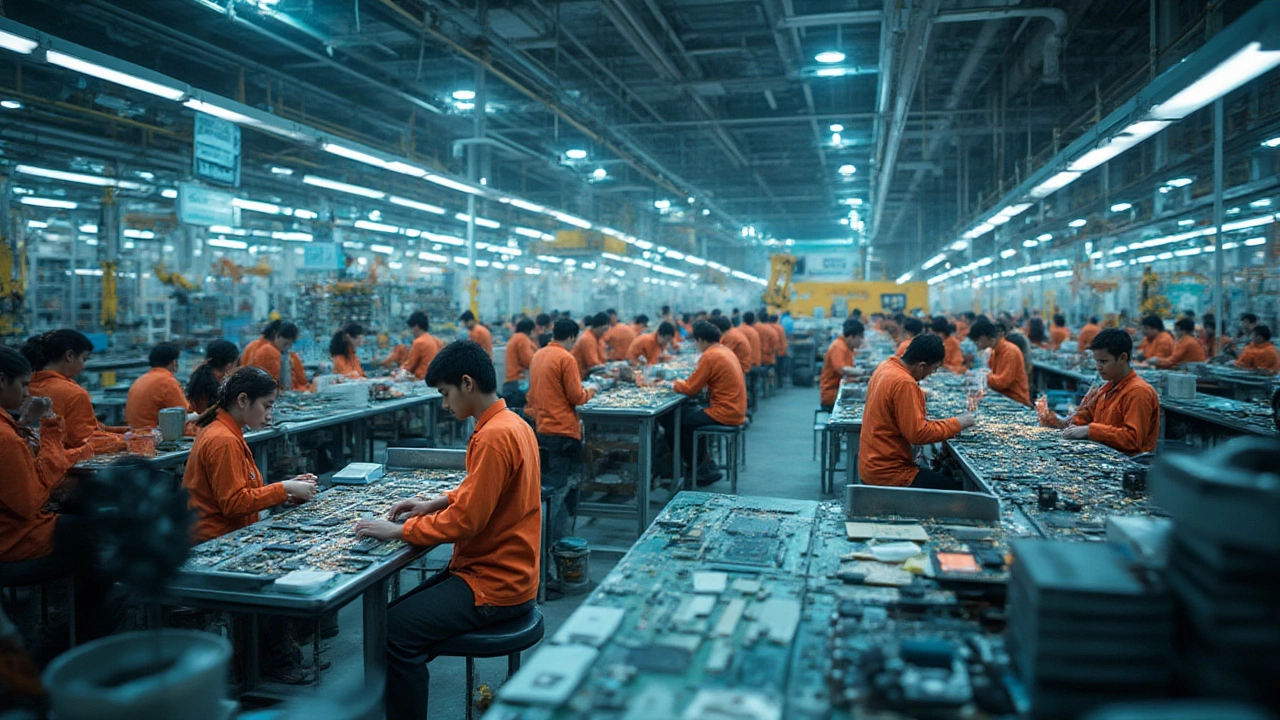Every time you flip open a smartphone or plug in a new TV, you might wonder: where did this thing actually come from? In the past, the answer was almost always China. But right now, factory floors in India are churning out gadgets, gear, and gadgets at a rate that might just surprise you. Gone are the days when India’s electronics industry was all about imports and assembly. What's fueling this jump? Why do Apple, Samsung, and Xiaomi double down on Indian plants? The answer goes way beyond tariffs and cheap labor. Let’s pull back the curtain on just how much electronics India really produces—and why it’s making headlines across the world.
Breaking Down the Numbers: How Much Electronics Does India Manufacture?
Start with some straight-up facts. Back in 2014, India’s annual electronics production sat around $29 billion. Fast-forward to the end of 2024, and the country is expected to hit nearly $110 billion worth of electronics output, according to official data from the Ministry of Electronics and Information Technology (MeitY) and a bunch of leading trade bodies like ICEA and MAIT. That’s not some rounding error—it’s a real, measurable boom.
Look at the details: Over 2 billion mobile phones were assembled in India between 2014 and 2024, according to the India Cellular & Electronics Association. Aside from mobile phones, India is now home to factories that crank out televisions, laptops, tablets, LED lights, and wearable tech like smartwatches and fitness bands. The country’s share of global smartphone manufacturing, for instance, is now over 16%. That’s making India the second-largest mobile phone maker after China. Not too shabby for a country that, a decade ago, barely manufactured phone chargers locally!
Need some context? Here’s an easy-to-read table for the nitty-gritty:
| Year | Electronics Output (USD Billion) | Mobile Phones Produced (Million Units) | TVs Produced (Million Units) | Employment (Million) |
|---|---|---|---|---|
| 2014 | 28.8 | 58 | 12 | 1.6 |
| 2018 | 59.2 | 290 | 16 | 2.2 |
| 2022 | 87.1 | 310 | 21 | 2.5 |
| 2024 (est) | 110.0 | 370 | 23 | 2.9 |
Mobile phones grab the headlines, but move beyond that and you’ll see something wilder—India is now the world’s largest producer of LED bulbs, shipping out over 900 million bulbs every year! India-made electronics hit the export highway in a big way too: In 2024, electronics exports sailed past $25 billion, with smartphones making up more than half of that number. A quick tip for entrepreneurs: If you want to tap into the electronics gold rush, look not just at phones but at other growing markets—think wearables, EV components, and next-generation smart home gear.
Boomtowns and Big Names: Who’s Leading the Production Wave?
Dive a little deeper and you’ll see the action isn’t spread evenly everywhere. The main action maps right onto India’s new “electronics corridors.” Noida, Sriperumbudur, Bengaluru, Hyderabad, and Pune are now household names inside the industry. Factories in these areas are not just putting together gadgets—they’re full-blown manufacturing hubs where every part from circuit boards to display panels gets made or finished. Apple’s contract manufacturers, like Foxconn, Wistron, and Pegatron, have plowed billions into new facilities in Tamil Nadu and Karnataka alone.
It’s not just global names. Homegrown players like Dixon Technologies and Lava are snapping up contracts for TV assemblies, feature phones, and even tablets for government and export markets. In 2025, more than 35% of televisions sold in India are assembled by Indian firms, and Dixon controls 50% of the LED lighting market. Another one to watch? Syrma SGS, a Chennai-based electronics parts supplier that quietly owned the EV charging infrastructure market this year.
If you zoom in on mobile phones, Indian units are putting together—and testing—everything from battery packs to screens for the iPhone 15 and beyond. Even Google jumped on board, announcing its first-ever Pixel smartphone assembly line in 2024. Samsung’s Noida plant, for instance, is the world’s largest phone factory by volume, with a capacity to turn out 120 million units a year. Meanwhile, the government’s “Make in India” and Production Linked Incentive (PLI) schemes have showered the sector with tax breaks and support, giving both multinationals and local brands a reason to double down.
Here’s what tips the scale: These companies don’t just make for India—they’re shipping out to Europe, Africa, and even North America. That means, if you’re buying a mid-range smartphone, smart TV, or set-top box anywhere from Nairobi to Naples, there’s a real chance it was put together by Indian hands.

What’s Fueling the Surge? Policies, Push, and Pandemic Lessons
So, where did this windfall come from? Most folks point to the combination of government prodding, global market shifts, and, yes, a nudge from the pandemic. When the world faced chip shortages and supply chain headaches in 2021 and 2022, companies realized the old playbook—relying just on China—simply didn’t fly anymore. That opened the door for India to pitch itself as the next big thing.
Key fuels for the fire include:
- Production Linked Incentive (PLI) schemes: $10 billion earmarked for electronics, with incentives handed straight to manufacturers for every device made in India.
- Zero-duty imports on equipment and parts used for making finished goods, making it cheaper and easier for new factories to start.
- Swift, single-window clearance systems for big investments, reducing red tape that once scared off investors.
- Skilling programs that bring millions of new technicians, line workers, and engineers up to speed for modern electronics manufacturing.
- State-level policies where Tamil Nadu, UP, and Telangana compete to attract the biggest names with tax holidays and cheap land.
But don’t think it’s all a government-driven fairy tale. There’s intense demand inside India: over 600 million smartphone users by mid-2025, with millions more wanting affordable TVs and smart appliances. Homegrown and global companies are locked in unforgiving price wars—if you can make it cheaper at home, you grab more market share. Demand for smart gadgets is no longer just an urban thing. Tier 2 and 3 cities, even rural parts, now make up nearly 40% of all smartphone sales. That’s a tidal wave, and factories are scrambling to keep up.
Want a tip if you’re planning on riding this wave? Keep an eye on the latest policy tweaks—subsidy rules, local content requirements, and green tech incentives change fast. Missing one update can mean missing out on lakhs in incentives if you’re running a business or looking to invest in local supply chains.
Challenges on the Factory Floor: What’s Holding India Back?
No country climbs to the top without hitting bumps. India’s electronics industry still faces its share of tough tests. The big one: component manufacturing. Around 60% of core parts—think microchips, high-end displays, and certain sensors—still need to be imported, mostly from Southeast Asia and China. Even the sleekest Indian smartphone often carries a Made-in-Vietnam motherboard or a Korean memory chip.
This heavy import bill ($50 billion annually for electronics components in 2024) digs into profits and raises risks. Any hiccup, say, in global shipping or trade wars, hits Indian plants hard. The government’s “Semicon India” initiative is taking aim at this by funding homegrown semiconductor fabs and supplier parks. A lot of money has gone in, but results will take years to really move the needle.
Next up: skills. Even with fast-tracked training programs, plants regularly report high turnover for skilled jobs and sometimes struggle to find workers with cutting-edge skillsets. The pace of automation helps but comes with its own learning curve. Infrastructure, too, is on the mend but not perfect—power cuts, transport bottlenecks, and unpredictable internet speeds are still daily battles in some states.
If you’re thinking of starting up or investing, don’t expect zero red tape or a friction-free experience. Locally sourced parts, reliable logistics partners, and access to big export markets make or break the real winners. Talk to anyone running a plant in Noida or Hosur, and they’ll tell you—success is about learning to pivot, automate, and keep both government and global buyers happy.
For the day-to-day buyer, one practical tip: pay attention to after-sales service terms. Locally made gadgets often mean faster, cheaper repairs, and easier access to parts. If you’re buying in bulk for a business or resale, look for manufacturers with strong service footprints.
